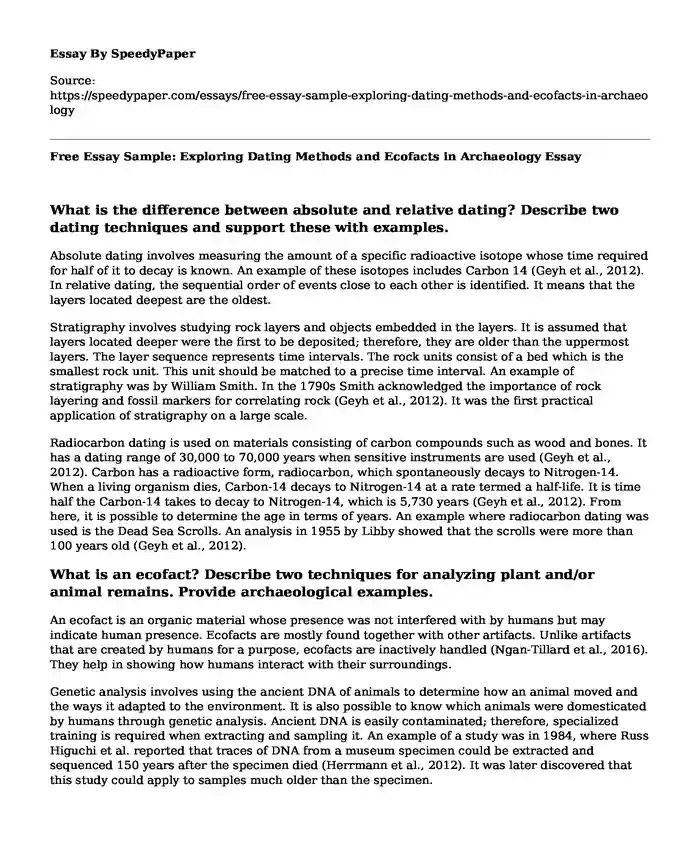What is the difference between absolute and relative dating? Describe two dating techniques and support these with examples.
Absolute dating involves measuring the amount of a specific radioactive isotope whose time required for half of it to decay is known. An example of these isotopes includes Carbon 14 (Geyh et al., 2012). In relative dating, the sequential order of events close to each other is identified. It means that the layers located deepest are the oldest.
Stratigraphy involves studying rock layers and objects embedded in the layers. It is assumed that layers located deeper were the first to be deposited; therefore, they are older than the uppermost layers. The layer sequence represents time intervals. The rock units consist of a bed which is the smallest rock unit. This unit should be matched to a precise time interval. An example of stratigraphy was by William Smith. In the 1790s Smith acknowledged the importance of rock layering and fossil markers for correlating rock (Geyh et al., 2012). It was the first practical application of stratigraphy on a large scale.
Radiocarbon dating is used on materials consisting of carbon compounds such as wood and bones. It has a dating range of 30,000 to 70,000 years when sensitive instruments are used (Geyh et al., 2012). Carbon has a radioactive form, radiocarbon, which spontaneously decays to Nitrogen-14. When a living organism dies, Carbon-14 decays to Nitrogen-14 at a rate termed a half-life. It is time half the Carbon-14 takes to decay to Nitrogen-14, which is 5,730 years (Geyh et al., 2012). From here, it is possible to determine the age in terms of years. An example where radiocarbon dating was used is the Dead Sea Scrolls. An analysis in 1955 by Libby showed that the scrolls were more than 100 years old (Geyh et al., 2012).
What is an ecofact? Describe two techniques for analyzing plant and/or animal remains. Provide archaeological examples.
An ecofact is an organic material whose presence was not interfered with by humans but may indicate human presence. Ecofacts are mostly found together with other artifacts. Unlike artifacts that are created by humans for a purpose, ecofacts are inactively handled (Ngan-Tillard et al., 2016). They help in showing how humans interact with their surroundings.
Genetic analysis involves using the ancient DNA of animals to determine how an animal moved and the ways it adapted to the environment. It is also possible to know which animals were domesticated by humans through genetic analysis. Ancient DNA is easily contaminated; therefore, specialized training is required when extracting and sampling it. An example of a study was in 1984, where Russ Higuchi et al. reported that traces of DNA from a museum specimen could be extracted and sequenced 150 years after the specimen died (Herrmann et al., 2012). It was later discovered that this study could apply to samples much older than the specimen.
Trace element analysis involves measuring small specific element concentrations available in a sample to determine alterations in the material (Pollard et al., 2015). Trace elements naturally occur in soils and sediments. Analysis of these materials can indicate the amount of trace elements available. For example, in 2002, Leah Minc and Jason Sherman did a Trace-element analysis of 168 ceramic samples to evaluate the relationship between ceramics from Zimatlan and Monte Alban (Pollard et al., 2015). The study enabled the researchers to establish the difference in rock layers in the two locations.
References
Erwin, D. H. (2011). Evolutionary uniformitarianism. Developmental biology, 357(1), 27-34.
Garrow, D., & Yarrow, T. (2010). Archaeology and anthropology: understanding similarity, exploring difference. Oxbow.
Geyh, M. A., & Schleicher, H. (2012). Absolute age determination: physical and chemical dating methods and their application. Springer Science & Business Media.
Herrmann, B., & Hummel, S. (Eds.). (2012). Ancient DNA: recovery and analysis of genetic material from paleontological, archaeological, museum, medical, and forensic specimens. Springer Science & Business Media.
Ngan-Tillard, D., Brinkgreve, R., Huisman, H., Van Meerten, H., Müller, A., & Van Kappel, K. (2016). Tools for predicting damage to archaeological sites caused by one-dimensional loading. Conservation and management of archaeological sites, 18(1-3), 70-85.
Pollard, A. M., & Heron, C. (2015). Archaeological chemistry. Royal Society of Chemistry.
Scott, A. C., & Damblon, F. (2010). Charcoal: Taphonomy and significance in geology, botany and archaeology. Palaeogeography, Palaeoclimatology, Palaeoecology, 291(1-2), 1-10.
Cite this page
Free Essay Sample: Exploring Dating Methods and Ecofacts in Archaeology. (2023, Dec 22). Retrieved from https://speedypaper.net/essays/free-essay-sample-exploring-dating-methods-and-ecofacts-in-archaeology
Request Removal
If you are the original author of this essay and no longer wish to have it published on the SpeedyPaper website, please click below to request its removal:
- Free Essay Sample on Memory Span
- Free Essay Sample: Comprehensive Risk Assessment of Water Shortage
- Free Essay Containing a Business Idea - Water Bottles That Have Filters
- Essay Sample on Chronic and Infectious Disease Control
- Essay Example: Big Data and Social Media
- Essay on Monsanto: A Big Biotech Company, With Many Stakeholders.
- Paper Example. A Priori Qualitative Research Article
Popular categories





